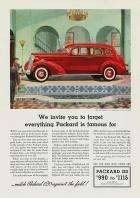|
Re: Packard 446/473 V12
|
||||
|---|---|---|---|---|
|
Forum Ambassador

|
The Packard factory engineering drawings I have are not dimensioned, but the spacing is not uniform. Each bank essentially has 3 pairs of 2 cylinders each, interrupted by wider spacing on either side of the middle pair to provide enough space below for the wide main bearings. That Packard chose to only stroke the engine going from the 445 to the 473 might suggest there was minimal room for enlarging the bore; you might get a clue as to how much room was left by looking at the parts list and seeing what was the largest oversize service piston they offered.
Looking again at those engineering drawings, there was little if any clearance below between the crankshaft counterweights and the block internals to again enlarge the stroke within the same block casting. I suspect the 473 was just about at it's practical limit - remember, it started life in the FWD prototype as a very small displacement engine. I'd guess the V12 with the most capacity for bore enlargement was the Pierce Arrow V-12 which went kept a constant stroke of 4 inches but went from a 3-1/4 inch bore (398 CI) to 3-1/2 (462 CI) under Pierce ownership and then when Seagrave took it over for fire engine use went to 3-3/4 for 530 CI in 1957.
Posted on: 2015/2/3 23:19
|
|||
|
||||
|
Re: Packard 446/473 V12
|
||||
|---|---|---|---|---|
|
Home away from home

|
Thanks that is interesting. Do you happen to know about the 320 and 385 engines. Where they enlarged earlier engines or initial designs. When they were eliminated where they at the end of being able to be enlarged.
Thanks John
Posted on: 2015/2/4 13:28
|
|||
|
John Rhodes
1953 Packard Patrician 1952 Packard 200 Deluxe |
||||
|
||||
|
Re: Packard 446/473 V12
|
||||
|---|---|---|---|---|
|
Forum Ambassador

|
Precursor to the 385 was the 1st and 2nd Series Single Eight, 3-3/8 x 5 for 358 CI, bored to 3-1/2 x 5 for the 3rd Series and remained so thru the 1936 Super Eight when the so-called "standard" Eight became renamed as the Super Eight. The Standard Eight started life in the 6th Series at 320 CI and remained so thru 1939. 3-1/2 x 5 was a common configuration, shared by the large Chrysler and Pierce-Arrow in-line 8s.
Without fiddling with decimals or rules of rounding, what you refer to as the 446 is commonly referenced as 445. And the 358 sometimes referenced as 357.
Posted on: 2015/2/4 13:48
|
|||
|
||||
|
Re: Packard 445/473 V12
|
||||
|---|---|---|---|---|
|
Home away from home

|
Thanks
So the 357/358 became the 385 The 320 was always a 320 and was never enlarged. These 2 engines were completely different I assume and didn't share a common block casting? Do you know the cylinder spacing on the 385 and 320? I am guessing the 385 was probably enlarged all the way but not the 320. Thanks John Trying to understand the whys of Packard pre-war engine development.
Posted on: 2015/2/4 14:34
|
|||
|
John Rhodes
1953 Packard Patrician 1952 Packard 200 Deluxe |
||||
|
||||
|
Re: Packard 445/473 V12
|
||||
|---|---|---|---|---|
|
Forum Ambassador

|
Thought the 320 and 385 share the same engineering fundementals and design and look much the same externally and internally, they share very little in common with regard to interchangeable parts. Oil pan, crankcase, cylinder block, cylinder head, etc. are longer on the 385 engine. Connecting rods, though they are the same stroke, are different as obviously are the crankshaft, camshaft, valves, pistons and pins, water pumps, etc. Factory pistons for oversizes were to 0.045" on either bore.
Posted on: 2015/2/4 15:45
|
|||
|
||||
|
Re: Packard 446/473 V12
|
||||
|---|---|---|---|---|
|
Home away from home

|
The new Su8 easily outperformed the V-12 and the unit sales couldn't possibly justify keeping an antique motor. The unit already was weakened by the bore and stroke method of increasing horsepower. Cooling system wise it was a thermal efficiency disaster. So any multi-cylinder project would be a waste of money without a blank sheet of paper.
GM did that when they authorized the OHV V-8. They dropped the V-16 because the Hydramatic made those cylinders unnecessary.
Posted on: 2015/2/4 18:06
|
|||
|
||||
|
Re: Packard 446/473 V12
|
||||
|---|---|---|---|---|
|
Home away from home

|
Hi
Both the 320 and 385 ci straight eights were still the old separate crankcase/cylinder block build method from the 1920's when mono-bloc method was becoming the norm by the mid-1930's. Oddly enough, the 445/473 twelve and the 120 engines are a monobloc builds. For whatever reason, management didn't immediately follow-up with a monobloc straight eight replacement for the Senior line in 1936-37 as one might expect. That would happen with the 1940 160/180 356 ci engine. Steve
Posted on: 2015/2/4 18:24
|
|||
|
.....epigram time.....
Proud 1953 Clipper Deluxe owner. Thinking about my next Packard, want a Clipper Deluxe Eight, manual shift with overdrive. |
||||
|
||||
|
Re: Packard 446/473 V12
|
||||
|---|---|---|---|---|
|
Home away from home

|
Thanks so the v12 had overheating issues? Didnt the v12 debut in 1932 and last till 1939. Thats only 8 years. Other engines were produced longer by Packard. So was the v12 an antique in 1939?
Thanks John
Posted on: 2015/2/4 18:53
|
|||
|
John Rhodes
1953 Packard Patrician 1952 Packard 200 Deluxe |
||||
|
||||
|
Re: Packard 446/473 V12
|
||||
|---|---|---|---|---|
|
Forum Ambassador

|
No, the Twelve didn't have inherent overheating issues, but its thermal efficiency was poor compared to simpler and less costly to produce engines. And Packard's competitors were dropping their monster old engines at the same time.
Posted on: 2015/2/4 19:11
|
|||
|
||||








